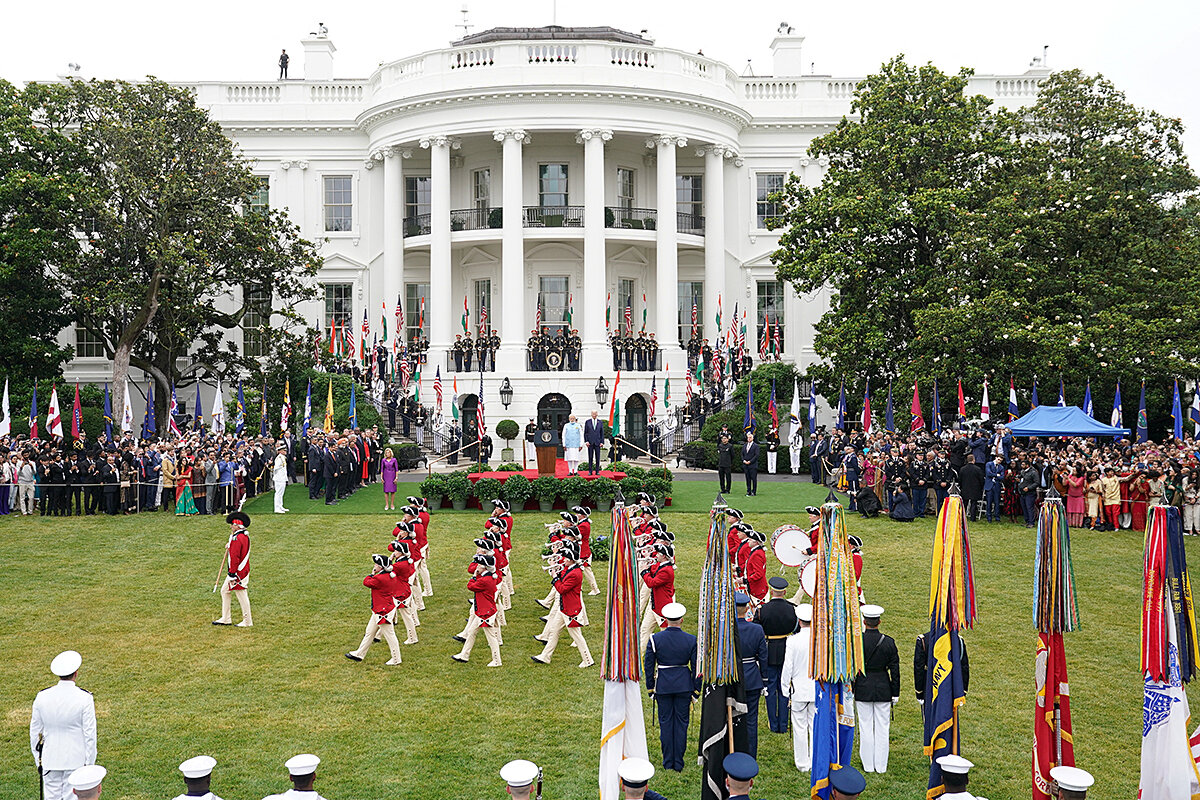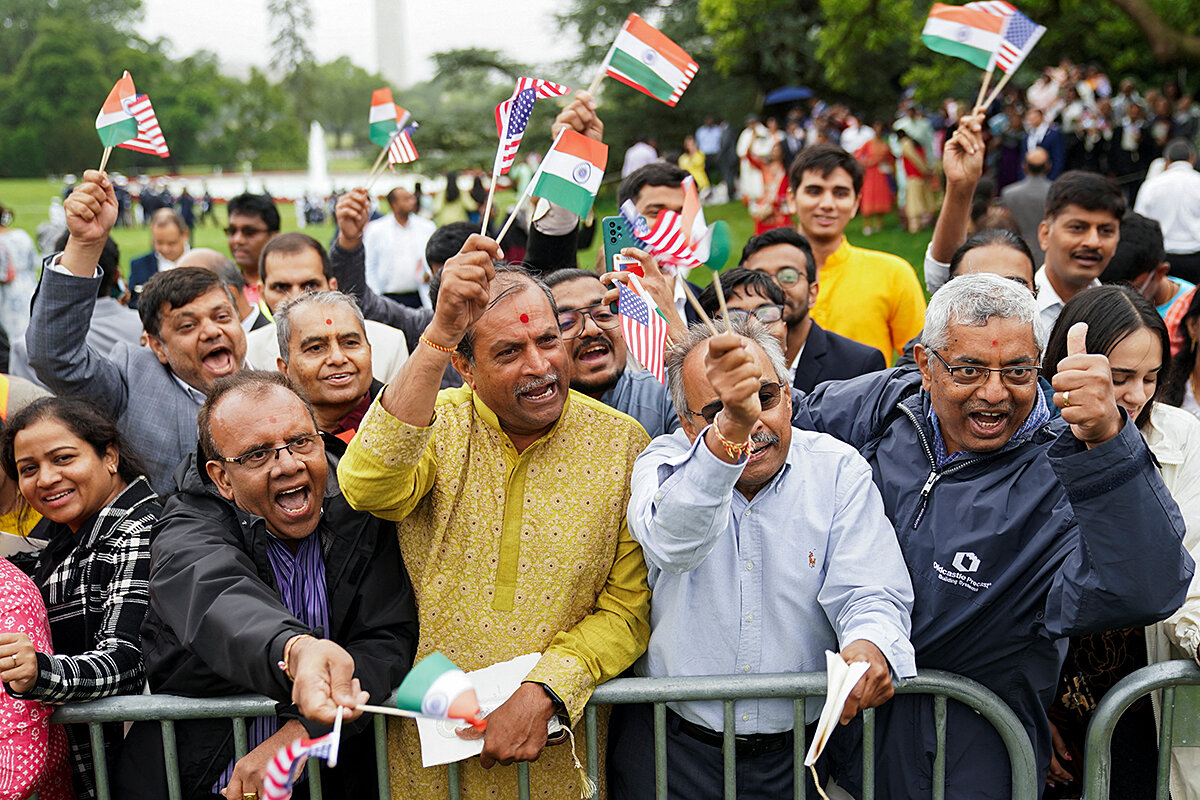India, the US, and ‘friendversaries’
Loading...
| London
How do you treat a “friendversary”?
The competing characteristics of the U.S.-India relationship are in full view this week as Prime Minister Narendra Modi visits Washington. Despite enthusiasm on both sides for strengthening relations between the democracies, U.S. policymakers know India, whose interests often differ from those of the United States, is unlikely to become a full-scale ally and friend. Yet they want to keep India close.
Why We Wrote This
A story focused onIt’s always easier to deal with close allies. But equally important to the U.S. is learning to better cooperate with key countries that share some interests while diverging on others.
India, which borders China, is the world’s fifth-largest economy. The U.S. recently displaced China as India’s main trading partner. Yet, India’s main arms supplier is Russia, and India has abstained from U.N. votes condemning the Ukraine invasion while buying cheap Russian oil. Its relations with China, too, are a mix of rivalry and partnership.
And while India prides itself on being the world’s largest democracy, Mr. Modi’s brand of Hindu nationalism has led to discrimination and violence against the country’s Muslim minority – and restraints on media and opposition voices.
Still, the Biden administration’s view of India as a rising counterweight to China’s regional dominance is clear, as is the determination to build on shared interests while finessing the differences.
There will be no shortage of pomp and circumstance, hugs and handshakes, as Washington lays on a lavish welcome for an increasingly key partner in Asia: India’s Prime Minister Narendra Modi.
Yet, the most important aspect of the visit, which includes an address to Congress and a state dinner Thursday, may get lost in the atmospherics.
It’s that, despite genuine enthusiasm on both sides for strengthening relations between the two democracies, U.S. policymakers know that India is never likely to become a full-scale ally and friend.
Why We Wrote This
A story focused onIt’s always easier to deal with close allies. But equally important to the U.S. is learning to better cooperate with key countries that share some interests while diverging on others.
It is one of a number of strategically located “friendversaries” – countries with the shared interests typical of allies, but also adversarial interests, priorities, and even values. Washington is keen to keep them as close as possible. And that delicate task has taken on greater urgency as a result of Russia’s war against Ukraine and the escalating U.S. rivalry with China.
Among other friendversaries are states like South Africa and Saudi Arabia.
But India may be the most important to Washington’s main long-term challenge: finding a way to compete with and, where necessary, constrain China without risking head-on conflict.
India borders China, a frontier that flared into violence as recently as several years ago. It’s a member of the so-called Quad – the Quadrilateral Security Dialogue – alongside the United States, Australia, and Japan.
Earlier this year, it overtook China as the world’s most populous nation. Its economy has become the world’s fifth-largest, and, though it is still far smaller than China’s, it’s growing more rapidly. Annual trade with the U.S. has increased to some $130 billion, and America recently displaced China as India’s main trading partner.
Talks also began this year on joint technology projects in areas including semiconductors, aerospace, and artificial intelligence.
But that’s the friend part of friendversary.
The “adversary” piece
On the adversary side of the scales, India’s main arms supplier is Russia – a carry-over from India’s prominent, often distinctly Moscow-friendly role in the nonaligned movement during the Cold War. And while Mr. Modi has voiced displeasure with the Ukraine war, India has abstained from U.N. votes condemning the invasion. Ignoring calls to sanction Moscow, it has been eagerly buying up cut-price Russian oil.
Its relations with China, too, are a mix of rivalry and partnership. India and China sit side by side in the BRICS economic alliance, which also includes Russia, South Africa, and Brazil.
And while India prides itself on being the world’s largest democracy, Mr. Modi’s brand of Hindu nationalism has led to discrimination and violence against members of the country’s 200-million-strong Muslim minority – as well as restraints on the media and opposition political voices.
Still, Prime Minister Modi’s state visit is evidence that Washington sees India as a rising counterweight to China’s regional dominance, and that the Biden administration is determined to find a way to build on shared interests with India while finessing the differences.
That’s an especially tricky balance for a U.S. president who has made the contest between democracy and autocracy his central foreign policy theme. Mr. Modi’s human rights record and response to the Ukraine war will surely come up during the visit – but only glancingly, if at all, in public.
Still, with bipartisan support for a firm stance on China, and business enthusiasm for widening economic ties, President Joe Biden’s embrace of Mr. Modi is unlikely to face major pushback.
That’s not the case, however, with two friendversaries in other areas of the globe where China and Russia have been expanding their influence: South Africa and Saudi Arabia.
South Africa is deeply tied to the U.S. economically, with nearly $11 billion in annual trade, including $3 billion in tariff-free exports under Washington’s African Growth and Opportunity Act (AGOA) initiative.
But South Africa, too, has resisted condemning the Ukraine invasion. It recently held a joint military exercise with Russia and China. And there have been reports, citing U.S. intelligence officials, that it’s been sending arms to Russia.
The Biden administration is clearly concerned a major diplomatic clash would undermine efforts to deepen U.S. influence in Africa: Officials say they’re still awaiting the results of an investigation by South African President Cyril Ramaphosa into the reported arms shipments.
But a bipartisan group in Congress has now urged the White House to relocate the annual meeting of AGOA from South Africa to elsewhere on the continent.
Friction with Saudi Arabia
There’s even stronger sentiment toward Saudi Arabia.
A key U.S. ally for decades, it still relies on America for security and military hardware.
Areas of friction have been growing, however.
The starkest one remains the 2018 murder of U.S.-based Saudi writer Jamal Khashoggi in the Saudi consulate in Istanbul. But Saudi Arabia has also strengthened ties with Russia and China. And when pressed by Washington to increase oil production after the Russian invasion, the Saudis reduced output instead.
Again, Mr. Biden seems reluctant to risk further fraying ties. Saudi Arabia’s de facto leader, Crown Prince Mohammed bin Salman, has become the leading political voice in the Arab world, and the concern is that a full-scale rift could simply encourage greater Chinese influence.
Finding common ground with the Saudis will be especially challenging for Mr. Biden. He was appalled by the Khashoggi murder, saying during his presidential campaign that it had made Saudi Arabia a “pariah state.”
Still, with his wider focus on Russia and above all China, America’s main international rivals, he seems to have concluded that a change in approach is necessary – that Washington needs to view Saudi Arabia not as the key ally it was for many decades, but instead, as a key friendversary.











